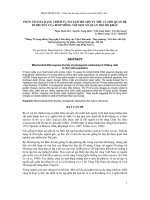Classification essay mẫu about social media không thể bỏ qua
Bạn đang xem bản rút gọn của tài liệu. Xem và tải ngay bản đầy đủ của tài liệu tại đây (59.43 KB, 5 trang )
Types of Social Media Users
One of the many changes brought about by the Digital Revolution was the
appearance of social media websites and phone applications that have
transformed the way people communicate and share news, opinions, facts, and
ideas in the 21st century.
For the first time in history, people went from being passive consumers of
information to its creators, as they are now able to share everything they
experience not only through text, but also through videos, photos, songs, and a
variety of other means. Based on how many social media platforms individuals
use and how actively they participate there, users can be divided into the
following six categories: no-shows, newcomers, onlookers, cliquers, mix-nminglers, and sparks.
Before proceeding to explain the differences between these groups, it is
important to understand what the term “social media” actually means. This term
is often confused with a subtype of social media – social networks such as
Facebook and Twitter, but it is, in fact, much broader. Evans defines it as
“participatory online media where news, photos, videos, and podcasts are made
public via social media websites through submission” (46).
Thus, social media includes not only one’s personal profile created for
communication with others, but it also consists of a range of other services like
YouTube, SoundCloud, Wikipedia, Pinterest, Tumblr, and phone applications
such as Snapchat, Instagram, and Foursquare, to name just a few. These tools
use different kinds and combinations of content, such as visual, textual, and
auditory, but their common trait is that their users, who can be a teenager in
Malaysia or a professor in Germany, are the ones generating their content.
Currently, social media is used not only for daily communication by
individuals, but also by politicians, governments, and companies. Statistics best
demonstrate its growing importance in everyday life. As of 2015, 65% of adults
in America use social media sites, compared to only 11% ten years earlier
(Loechner par. 1). The use of social media also becomes more and more
widespread, regardless of demographic differences.
For example, in 2005 only 2% of those 65 and older used social media,
while currently, this number has grown to 35% (Loechner par. 4). There are no
significant gender and racial differences between social media users, and the
main demographic difference concerns individuals’ level of income and their
place of living – urban or rural areas (Loechner par. 5-7). This difference thus
does not mean that these people do not want to use social media, but rather that
they do not have the necessary technology or infrastructure for that.
Therefore, when it comes to the classification of social media users, the two
most important characteristics are their level of participation (how often they
post something or otherwise engage with the website) and the degree of their
exposure to different platforms (how many sites they use). Based on these two
criteria, Dyer writes about a six-group classification of social media users: noshows, newcomers, onlookers, cliquers, mix-n-minglers, and sparks (par. 6-11).
Common traits of no-shows and newcomers are low exposure and passive
participation on social media platforms. No-shows, or those who created a
profile but rarely or almost never use it, make up about 41% of social media
users. They are typically elderly people who do not trust new media and are not
interested in using it (Dyer par. 6). Newcomers are slightly more active than noshows as they use social media, namely social networks, to maintain their reallife relationships, and they represent about 15% of users. However, newcomers
usually join these websites not because they are genuinely interested but
because they did not want to feel “left out” (Dyer par. 7). The network of choice
for these groups is usually Facebook.
On the other side of the spectrum are the onlookers, who, while being
passive participants, are exposed to more social media platforms. They make up
about 16% of all users, and they frequently visit social media websites to learn
the news from the lives of others but rarely post themselves. Onlookers are
silent watchers because they like to maintain tight control of their personal
information (Dyer par. 8).
Their complete opposites are the cliques, making up about 6% of social
media users. Just like no-shows and newcomers, cliquers’ presence on social
media is usually limited to one network, mainly Facebook. However, they
participate actively by sharing photos and posting and commenting on status
updates. Cliquers are usually known only within their smaller circle of friends
and acquaintances, but they are quite influential within this circle (Dyer par. 9).
Finally, there are two groups of users who are present across several social
media platforms where they actively create and engage with content. The more
populated group, representing 19% of all users, has been labeled as mix-nminglers. Apart from their regular day-to-day communication with their friends,
mix-n-minglers use social media to learn the latest news and to follow
influential people and brands.
When
communicating
online,
mix-n-minglers
both
maintain
old
relationships and create new ones with other active users (Dyer par. 10). Sparks,
the rarest group of users, representing only about 3% of total users, are just very
active mix-n-minglers. For sparks, social media is another tool for selfexpression: rather than merely following others, they actively create content and
become the ones who are followed (Dyer par. 11). They do not just listen to
online conversations – they shape them.
Classification based on participation and exposure is important because, as
research indicates, it can also reveal additional information about the
personality characteristics of users in each category. On-lookers, mix-nminglers, and sparks are more likely to be teenagers and young adults, as
Millennials (those born in the 1990s and later) grew up in the digital era and are
thus considered “digital natives” (Correa, Hinsley, and Zúñiga 252).
For them, social media is part of their entire life experience, while “digital
immigrants”, or those in their 40s and older, see it as a change to which they
need to adapt (Correa, Hinsley, and Zúñiga 252). Elderly people and adults thus
mostly fall in the categories of no-shows and newcomers. Apart from age
differences, this classification also reveals different lifestyle choices and
personality traits: the more actively people participate in social media, the more
extraverted and open to new experiences they tend to be (Correa, Hinsley, and
Zúñiga 252).
This classification thus provides many insights for anyone interested in
understanding how people use and engage with social media. Most importantly,
it can help marketing and advertising professionals reach out to their potential
customers by placing advertisements on platforms they frequently visit and by
adjusting the content to this specific group. For similar reasons, it also serves as
an important networking and political campaigning tool. Therefore, those who
would like to use social media for professional purposes should consider the
kind of users they are looking to engage – no-shows, newcomers, onlookers,
cliquers, mix-n-minglers, or sparks – and then choose the appropriate platform
and methods for doing so.
Works Cited
Correa, Teresa, Amber Willard Hinsley, and Homero Gil De Zúñiga. “Who
Interacts on the Web?: The Intersection of Users’ Personality and Social Media
Use.” Computers in Human Behavior 26.2 (2010): 247-53. Web.
Dyer, Pam. “The 6 Types Of Social Media Users.” Social Media Today.
2012. Web.
Evans, Dave. Social Media Marketing: An Hour a Day. Indianapolis,
Indiana: John Wiley & Sons, 2012. Web.
Loechner, Jack. “65% Of All American Adults Using Social Media.”
MediaPost. 2015. MediaPost Communications. Web.
THƠNG TIN HỎI ĐÁP:
-------------------------Trong q trình làm bài Essay, bạn muốn tìm kiếm thêm nhiều tài liệu bài
mẫu, cách làm bài Essay cập nhật mới của Trung tâm Best4Team
Liên hệ dịch vụ thuê viết essay tiếng anh
Hoặc qua SĐT Zalo: 091.552.1220 hoặc email:
để hỗ trợ ngay nhé!









